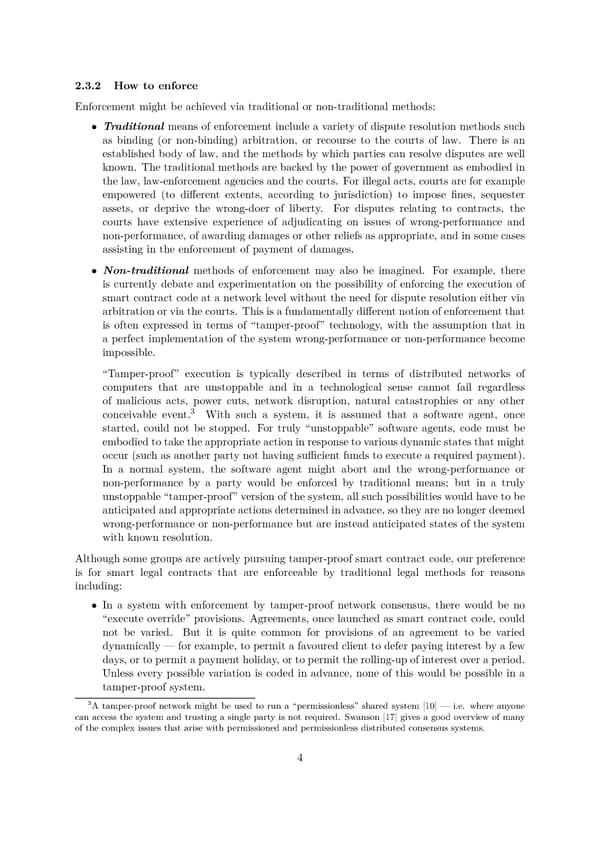2.3.2 How to enforce Enforcement might be achieved via traditional or non-traditional methods: • Traditional means of enforcement include a variety of dispute resolution methods such as binding (or non-binding) arbitration, or recourse to the courts of law. There is an established body of law, and the methods by which parties can resolve disputes are well known. The traditional methods are backed by the power of government as embodied in the law, law-enforcement agencies and the courts. For illegal acts, courts are for example empowered (to different extents, according to jurisdiction) to impose fines, sequester assets, or deprive the wrong-doer of liberty. For disputes relating to contracts, the courts have extensive experience of adjudicating on issues of wrong-performance and non-performance, of awarding damages or other reliefs as appropriate, and in some cases assisting in the enforcement of payment of damages. • Non-traditional methods of enforcement may also be imagined. For example, there is currently debate and experimentation on the possibility of enforcing the execution of smart contract code at a network level without the need for dispute resolution either via arbitration or via the courts. This is a fundamentally different notion of enforcement that is often expressed in terms of “tamper-proof” technology, with the assumption that in a perfect implementation of the system wrong-performance or non-performance become impossible. “Tamper-proof” execution is typically described in terms of distributed networks of computers that are unstoppable and in a technological sense cannot fail regardless of malicious acts, power cuts, network disruption, natural catastrophies or any other conceivable event.3 With such a system, it is assumed that a software agent, once started, could not be stopped. For truly “unstoppable” software agents, code must be embodiedtotaketheappropriateactioninresponsetovarious dynamic states that might occur (such as another party not having sufficient funds to execute a required payment). In a normal system, the software agent might abort and the wrong-performance or non-performance by a party would be enforced by traditional means; but in a truly unstoppable “tamper-proof” version of the system, all such possibilities would have to be anticipated and appropriate actions determined in advance, so they are no longer deemed wrong-performance or non-performance but are instead anticipated states of the system with known resolution. Although some groups are actively pursuing tamper-proof smart contract code, our preference is for smart legal contracts that are enforceable by traditional legal methods for reasons including: • In a system with enforcement by tamper-proof network consensus, there would be no “execute override” provisions. Agreements, once launched as smart contract code, could not be varied. But it is quite common for provisions of an agreement to be varied dynamically — for example, to permit a favoured client to defer paying interest by a few days, or to permit a payment holiday, or to permit the rolling-up of interest over a period. Unless every possible variation is coded in advance, none of this would be possible in a tamper-proof system. 3A tamper-proof network might be used to run a “permissionless” shared system [10] — i.e. where anyone can access the system and trusting a single party is not required. Swanson [17] gives a good overview of many of the complex issues that arise with permissioned and permissionless distributed consensus systems. 4
 Position Paper | Smart Contract Templates Page 5 Page 7
Position Paper | Smart Contract Templates Page 5 Page 7